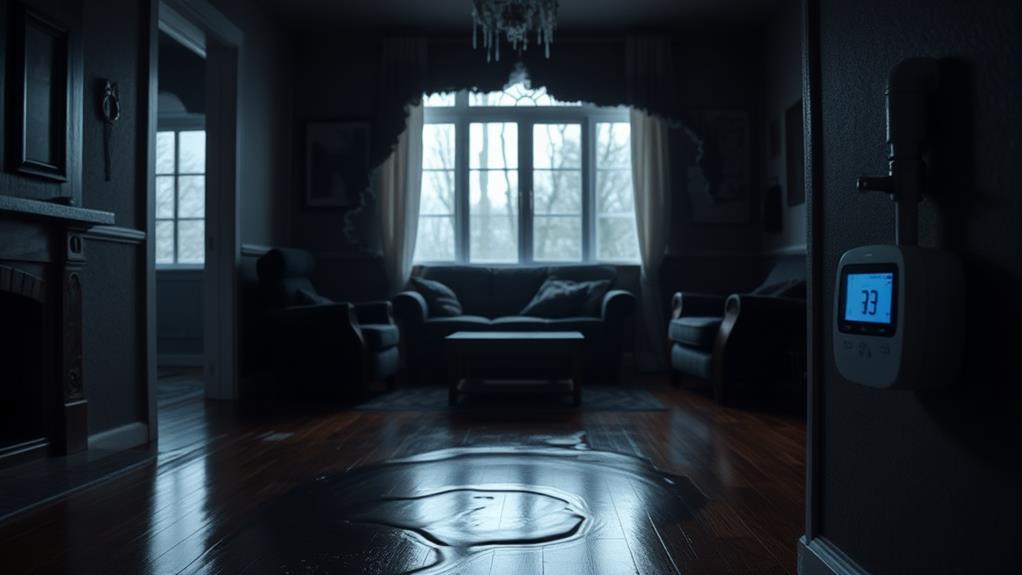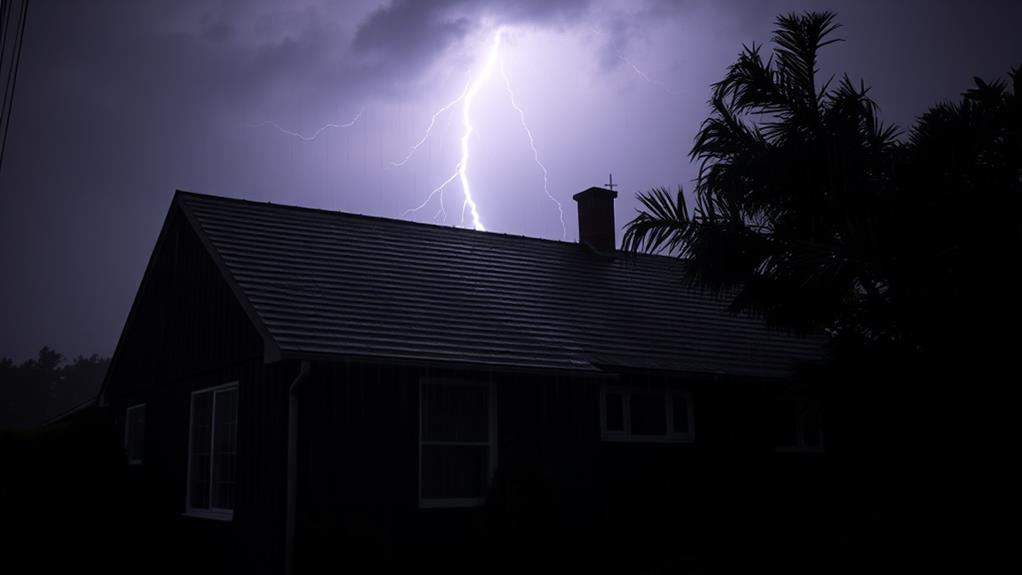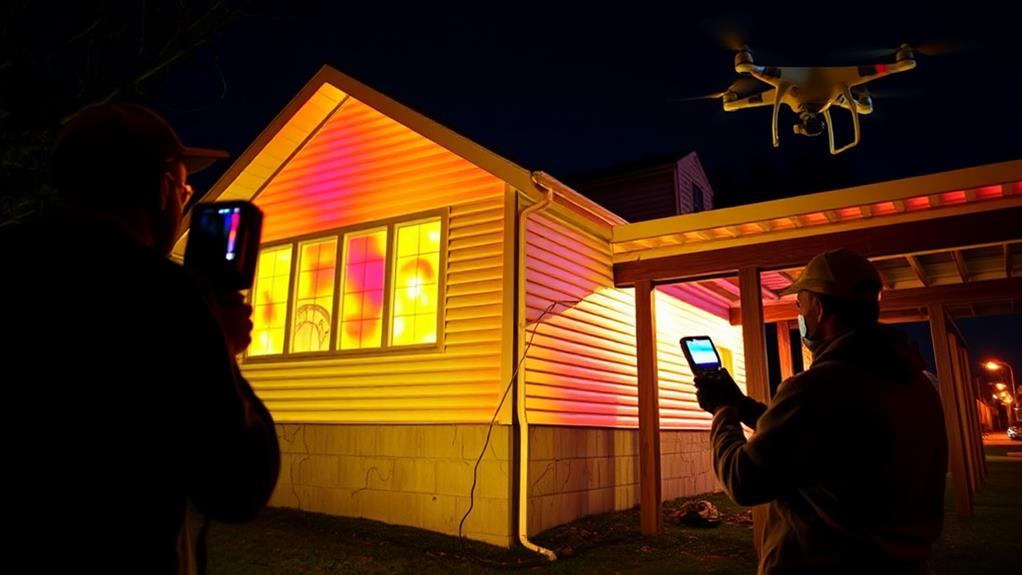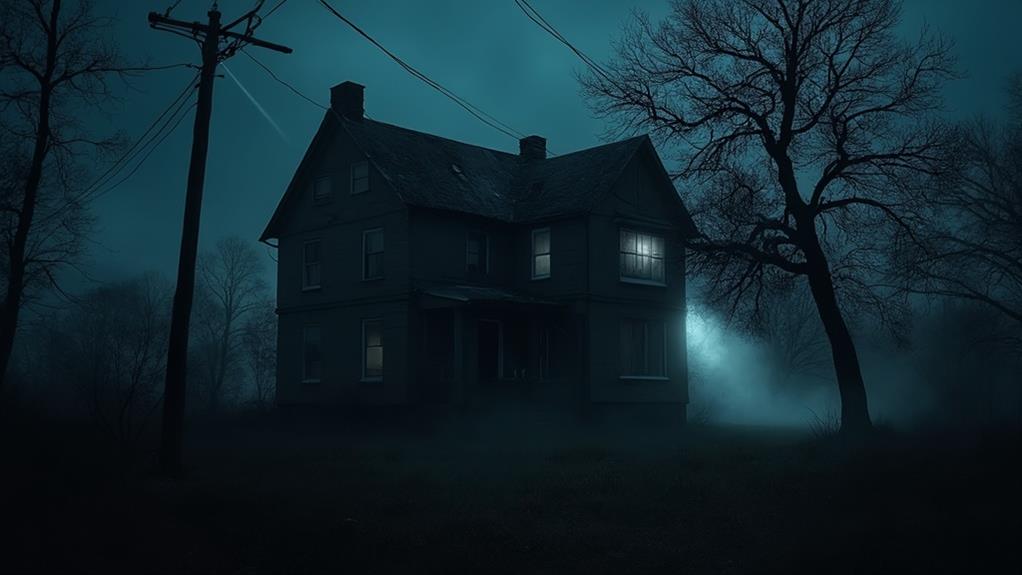Power outages can cause significant long-term structural issues in homes. Frozen pipes may burst, leading to water damage. Increased humidity can promote mold and mildew growth. Foundation cracks and settling can occur due to water accumulation and temperature fluctuations. Electrical systems may be vulnerable to overloading and outdated wiring. Roof and gutter problems can worsen during outages, causing leaks and water infiltration. HVAC system failures can result in poor air quality and moisture buildup. To prevent these issues, homeowners should implement backup power solutions, maintain critical systems, and conduct regular inspections. Exploring advanced monitoring techniques can further safeguard your home's structural integrity.
Frozen Pipes and Water Damage

When temperatures plummet, the risk of frozen pipes skyrockets, potentially leading to extensive water damage in homes and buildings. During power outages, this risk intensifies as heating systems fail to maintain adequate temperatures. Frozen pipes can burst, causing water to flood living spaces, damage structural elements, and promote mold growth.
To prevent frozen pipes, insulate exposed plumbing in unheated areas such as attics, crawl spaces, and exterior walls. Allow faucets to drip slightly, promoting water movement and reducing freezing risk. Open cabinet doors beneath sinks to allow warm air circulation around pipes.
If power outages occur, shut off the main water supply and drain the system to minimize potential damage.
In the event of a pipe burst, act quickly to mitigate water damage. Shut off the water supply immediately and remove standing water using pumps or wet vacuums. Dry affected areas thoroughly with dehumidifiers and fans to prevent mold growth. Remove wet materials like carpeting and drywall to facilitate drying and prevent further damage. Document the damage for insurance purposes and consult professionals for repairs to ensure structural integrity and prevent long-term issues.
Mold and Mildew Growth
How does prolonged moisture from power outages and structural issues contribute to mold and mildew growth? Extended power outages can lead to increased humidity levels and moisture accumulation within homes, creating ideal conditions for mold and mildew to thrive. When HVAC systems are inoperable, air circulation is compromised, exacerbating the problem.
Additionally, structural issues like roof leaks or foundation cracks can allow water infiltration, further promoting fungal growth.
Mold and mildew can develop within 24-48 hours of moisture exposure, rapidly spreading across various surfaces. Common areas affected include drywall, carpets, insulation, and wooden structures. The presence of mold not only causes aesthetic damage but also poses significant health risks to occupants, including respiratory issues and allergic reactions.
To prevent mold growth during power outages, homeowners should prioritize moisture control. Use battery-operated fans or open windows to promote air circulation when possible. Remove standing water promptly and dry affected areas thoroughly. Consider using moisture-absorbing products like silica gel or calcium chloride in susceptible areas. Upon power restoration, run dehumidifiers and air conditioners to reduce indoor humidity levels. Regular inspections and prompt repairs of structural issues are crucial in maintaining a mold-free environment long-term.
Foundation Cracks and Settling

Foundation cracks and settling are serious structural issues that can compromise the integrity of a building. While not directly caused by power outages, these problems can be exacerbated by prolonged periods without electricity, especially in areas prone to flooding or extreme temperature fluctuations.
During power outages, sump pumps may fail, leading to water accumulation around the foundation. This excess moisture can cause soil expansion and contraction, potentially resulting in foundation movement and cracks. Additionally, the absence of climate control systems can lead to dramatic temperature changes within the structure, causing materials to expand and contract unevenly, further stressing the foundation.
To mitigate these risks, homeowners should consider installing battery backup systems for sump pumps and investing in portable generators to maintain essential systems during outages. Regular foundation inspections, particularly after extended power losses, can help identify early signs of damage. Proper grading and drainage around the house's perimeter can also reduce water accumulation near the foundation. In areas prone to frequent outages, reinforcing the foundation with steel piers or helical anchors may provide additional stability and protection against settling and cracking.
Electrical System Vulnerabilities
Identifying electrical system vulnerabilities is crucial for maintaining the safety and functionality of a building during power outages. Common vulnerabilities include outdated wiring, overloaded circuits, and inadequate surge protection. Older homes may have aluminum wiring or knob-and-tube systems, which are more prone to failure and fire risks. Insufficient capacity in the main electrical panel can lead to frequent tripping of circuit breakers, especially when multiple high-power devices are in use.
Exposed or damaged wiring, particularly in damp areas, poses a significant hazard. Loose connections at outlets, switches, or junction boxes can cause arcing and overheating. Lack of ground fault circuit interrupters (GFCIs) in wet locations increases the risk of electric shock. Improper grounding of electrical systems can lead to equipment damage and safety issues during power fluctuations.
To mitigate these vulnerabilities, regular electrical inspections by licensed professionals are essential. Upgrading outdated components, installing whole-house surge protectors, and ensuring proper grounding can significantly improve system resilience. Implementing a backup power solution, such as a generator or battery system, can provide critical support during extended outages, protecting both the electrical system and the building's structural integrity.
Roof and Gutter Issues

Three critical roof and gutter issues can exacerbate the impact of power outages on a building's structural integrity. First, clogged gutters can lead to water accumulation on the roof, increasing the risk of leaks and moisture damage during prolonged power outages when sump pumps are inoperative. This standing water can penetrate roofing materials, compromising the roof's ability to protect the home's interior.
Second, damaged or missing shingles leave the roof vulnerable to water infiltration, which can worsen rapidly during extended periods without power. Without the ability to quickly identify and address these issues, water damage can spread to the attic, walls, and foundation, potentially leading to mold growth and structural weakening.
Lastly, inadequate attic ventilation can cause excessive heat buildup during power outages, as mechanical ventilation systems become non-functional. This increased temperature can accelerate the deterioration of roofing materials and exacerbate any existing moisture problems. To mitigate these risks, homeowners should regularly inspect and maintain their roofs and gutters, ensuring proper drainage, intact shingles, and adequate ventilation. Additionally, installing a backup power source for critical systems can help prevent long-term structural damage during extended outages.
HVAC System Complications
During power outages, HVAC systems face significant challenges that can compromise a building's structural integrity and indoor air quality. Without electricity, these systems cease to function, leading to a cascade of potential issues.
The primary concern is moisture accumulation, as air circulation and dehumidification processes are interrupted. This can result in condensation forming on walls, ceilings, and within ductwork, potentially causing mold growth and deterioration of building materials.
Extended power outages during extreme weather conditions exacerbate these problems. In hot, humid climates, stagnant air and increased moisture levels can accelerate mold growth and wood rot. Conversely, in cold climates, the lack of heating can lead to frozen pipes, causing water damage when power is restored. Additionally, the absence of air filtration allows dust, allergens, and pollutants to accumulate, degrading indoor air quality.
To mitigate these risks, homeowners should consider installing backup power sources for essential HVAC components. Regular maintenance of HVAC systems, including cleaning and inspecting ductwork, can also help prevent complications during outages. Implementing passive ventilation strategies and using moisture-absorbing materials can further protect against structural damage and maintain a healthier indoor environment during prolonged power failures.
Structural Integrity Monitoring Techniques

While HVAC systems play a vital role in maintaining structural integrity, proactive monitoring techniques are necessary to detect and prevent potential issues before they escalate. Structural integrity monitoring involves various methods to assess a building's condition and identify potential weaknesses.
Visual inspections are fundamental, conducted regularly by trained professionals who examine walls, foundations, and roofs for cracks, moisture damage, or other signs of deterioration. Advanced technologies like thermal imaging cameras can detect hidden moisture or insulation problems.
Vibration monitoring systems use sensors to measure and analyze structural movements, helping identify abnormal patterns that may indicate instability. Strain gauges attached to critical load-bearing elements provide real-time data on stress levels, while tilt sensors detect subtle changes in a building's orientation. Laser scanning and photogrammetry create detailed 3D models of structures, allowing for precise comparisons over time to identify shifts or deformations.
For areas prone to seismic activity, accelerometers can measure ground motion and building response during earthquakes. Additionally, moisture meters and humidity sensors help monitor environmental conditions that could impact structural materials. Implementing a comprehensive monitoring program combining these techniques ensures early detection of potential structural issues, allowing for timely interventions and maintenance.
Frequently Asked Questions
How Can I Safely Use a Portable Generator During a Power Outage?
To safely use a portable generator during a power outage, ensure proper ventilation outdoors, maintain a safe distance from your home, use appropriate extension cords, avoid overloading, and never connect it directly to your home's electrical system.
What Essential Items Should Be Included in a Home Emergency Kit?
Picture a lifeline in troubled times: your home emergency kit. Essential items include non-perishable food, water, flashlights, batteries, first-aid supplies, medications, cash, important documents, multi-tool, blankets, and a battery-powered or hand-crank radio for vital information.
How Do Power Outages Affect Home Security Systems?
Power outages can significantly impact home security systems. Battery backups may maintain functionality for a limited time, but prolonged outages can disable alarms, cameras, and monitoring services. Consider backup power solutions or alternative security measures during extended blackouts.
Can Prolonged Power Outages Impact Property Values in a Neighborhood?
Imagine a neighborhood as a garden: reliable power is the sunlight it needs to thrive. Prolonged outages can indeed wilt property values, as potential buyers may view the area as less desirable, impacting market prices and overall appeal.
Are There Any Tax Deductions Available for Home Improvements Related to Outage Prevention?
While specific tax deductions for outage prevention improvements are limited, some energy-efficient upgrades may qualify for federal tax credits. Consult a tax professional or visit the IRS website for current information on available incentives for home improvements.
Conclusion
Power outages can inflict long-lasting damage on homes, much like a silent invader. Preventive measures and regular maintenance are crucial to mitigate risks associated with frozen pipes, mold growth, foundation issues, electrical vulnerabilities, roof damage, and HVAC complications. Implementing structural integrity monitoring techniques enables homeowners to detect and address potential problems early. By adopting a proactive approach, households can safeguard their properties against the cascading effects of power disruptions, ensuring resilience and preserving the home's value and safety.

